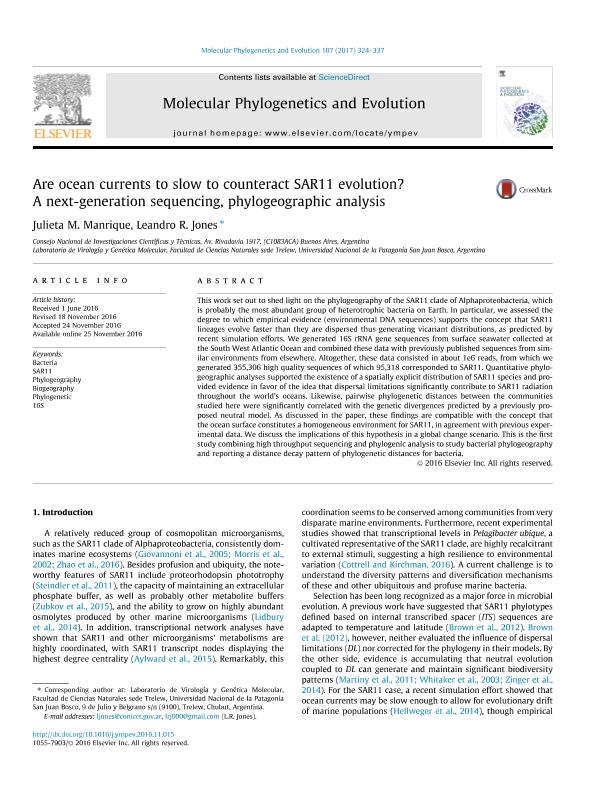Mostrar el registro sencillo del ítem
dc.contributor.author
Manrique, Julieta Marina

dc.contributor.author
Jones, Leandro Roberto

dc.date.available
2019-03-29T17:53:47Z
dc.date.issued
2017-02
dc.identifier.citation
Manrique, Julieta Marina; Jones, Leandro Roberto; Are ocean currents to slow to counteract SAR11 evolution? A next-generation sequencing, phylogeographic analysis; Academic Press Inc Elsevier Science; Molecular Phylogenetics and Evolution; 107; 2-2017; 324-337
dc.identifier.issn
1055-7903
dc.identifier.uri
http://hdl.handle.net/11336/72848
dc.description.abstract
This work set out to shed light on the phylogeography of the SAR11 clade of Alphaproteobacteria, which is probably the most abundant group of heterotrophic bacteria on Earth. In particular, we assessed the degree to which empirical evidence (environmental DNA sequences) supports the concept that SAR11 lineages evolve faster than they are dispersed thus generating vicariant distributions, as predicted by recent simulation efforts. We generated 16S rRNA gene sequences from surface seawater collected at the South West Atlantic Ocean and combined these data with previously published sequences from similar environments from elsewhere. Altogether, these data consisted in about 1e6 reads, from which we generated 355,306 high quality sequences of which 95,318 corresponded to SAR11. Quantitative phylogeographic analyses supported the existence of a spatially explicit distribution of SAR11 species and provided evidence in favor of the idea that dispersal limitations significantly contribute to SAR11 radiation throughout the world's oceans. Likewise, pairwise phylogenetic distances between the communities studied here were significantly correlated with the genetic divergences predicted by a previously proposed neutral model. As discussed in the paper, these findings are compatible with the concept that the ocean surface constitutes a homogeneous environment for SAR11, in agreement with previous experimental data. We discuss the implications of this hypothesis in a global change scenario. This is the first study combining high throughput sequencing and phylogenic analysis to study bacterial phylogeography and reporting a distance decay pattern of phylogenetic distances for bacteria.
dc.format
application/pdf
dc.language.iso
eng
dc.publisher
Academic Press Inc Elsevier Science

dc.rights
info:eu-repo/semantics/openAccess
dc.rights.uri
https://creativecommons.org/licenses/by-nc-nd/2.5/ar/
dc.subject
16s
dc.subject
Bacteria
dc.subject
Biogeography
dc.subject
Phylogenetic
dc.subject
Phylogeography
dc.subject
Sar11
dc.subject.classification
Otras Ciencias Biológicas

dc.subject.classification
Ciencias Biológicas

dc.subject.classification
CIENCIAS NATURALES Y EXACTAS

dc.title
Are ocean currents to slow to counteract SAR11 evolution? A next-generation sequencing, phylogeographic analysis
dc.type
info:eu-repo/semantics/article
dc.type
info:ar-repo/semantics/artículo
dc.type
info:eu-repo/semantics/publishedVersion
dc.date.updated
2019-03-29T12:10:30Z
dc.journal.volume
107
dc.journal.pagination
324-337
dc.journal.pais
Estados Unidos

dc.description.fil
Fil: Manrique, Julieta Marina. Universidad Nacional de la Patagonia "San Juan Bosco". Facultad de Ciencias Naturales - Sede Trelew; Argentina. Consejo Nacional de Investigaciones Científicas y Técnicas; Argentina
dc.description.fil
Fil: Jones, Leandro Roberto. Universidad Nacional de la Patagonia "San Juan Bosco". Facultad de Ciencias Naturales - Sede Trelew; Argentina. Consejo Nacional de Investigaciones Científicas y Técnicas; Argentina
dc.journal.title
Molecular Phylogenetics and Evolution

dc.relation.alternativeid
info:eu-repo/semantics/altIdentifier/doi/http://dx.doi.org/10.1016/j.ympev.2016.11.015
dc.relation.alternativeid
info:eu-repo/semantics/altIdentifier/url/https://www.sciencedirect.com/science/article/pii/S1055790316303761
Archivos asociados
